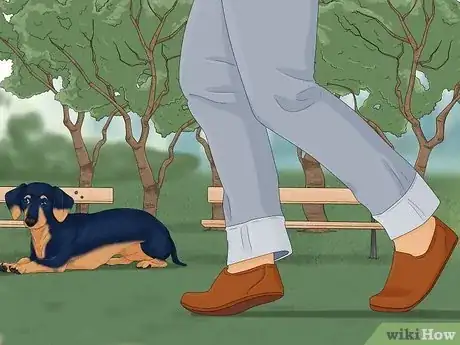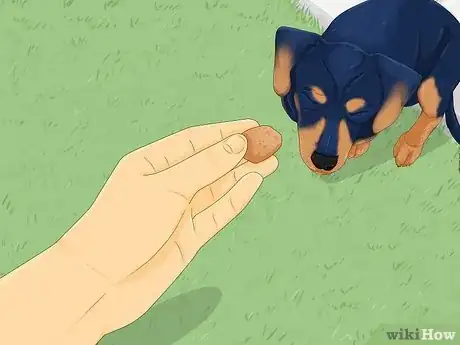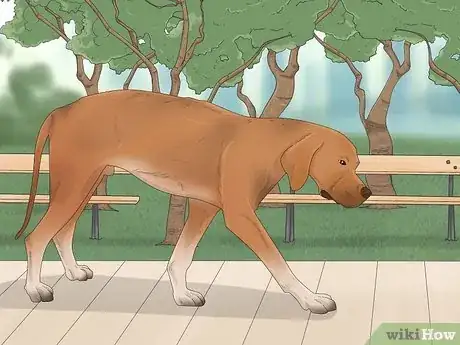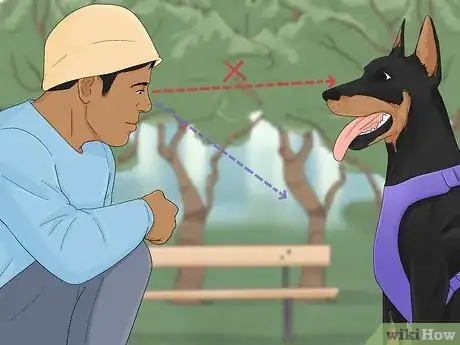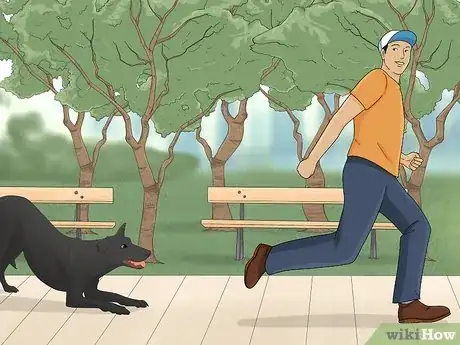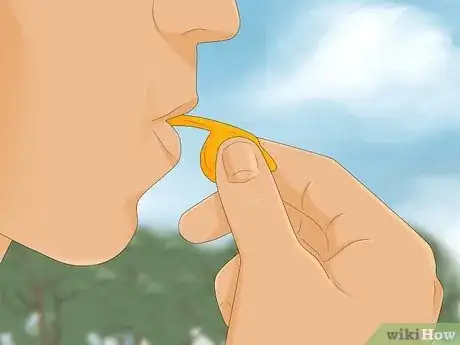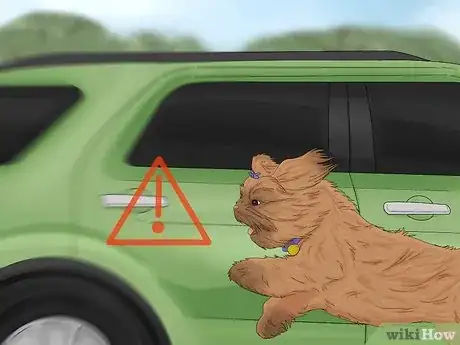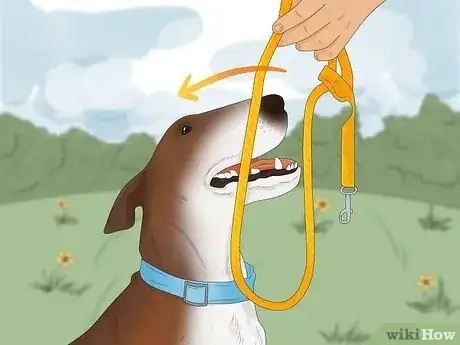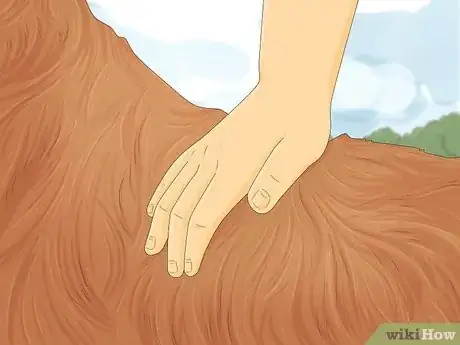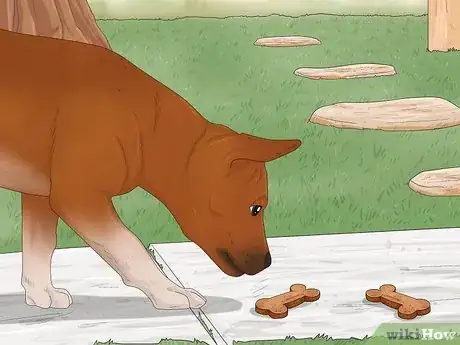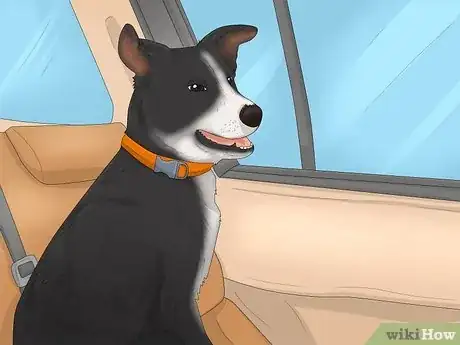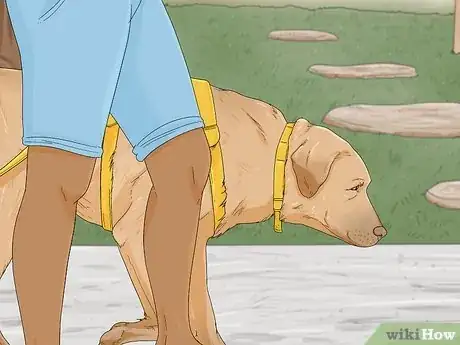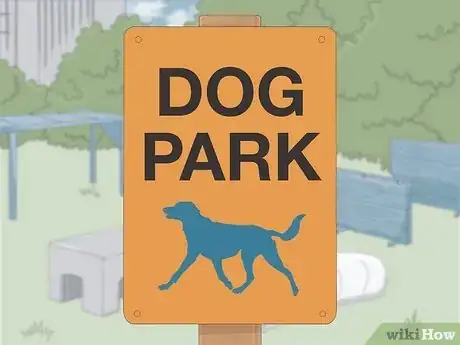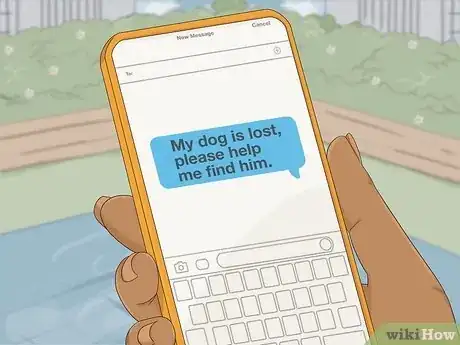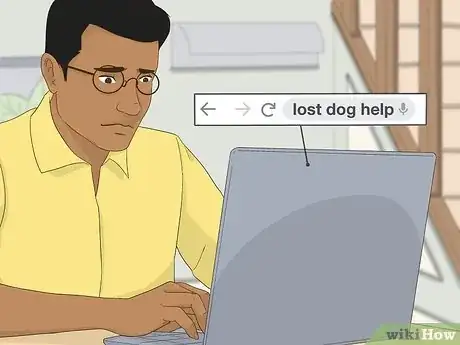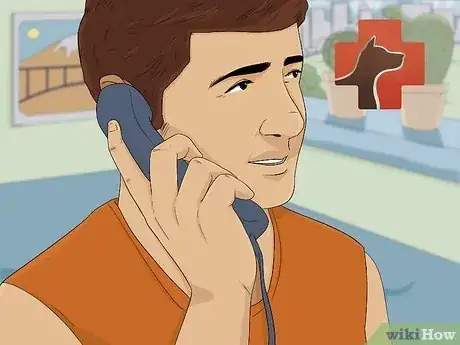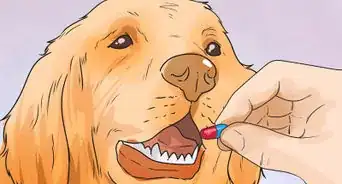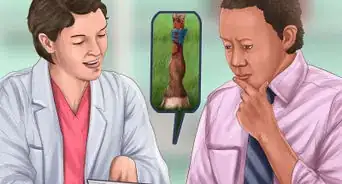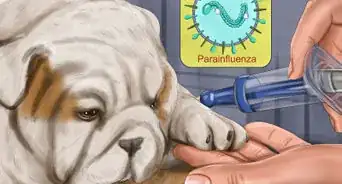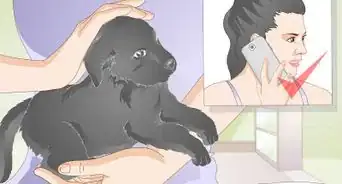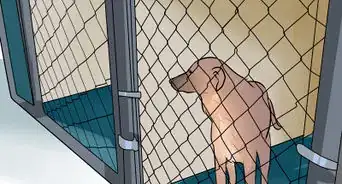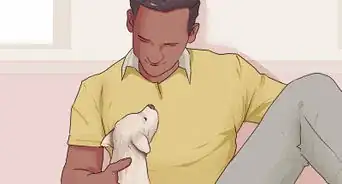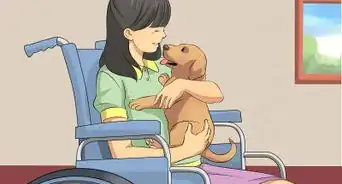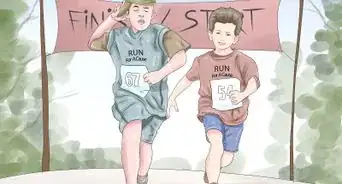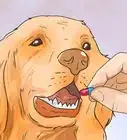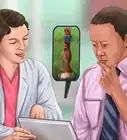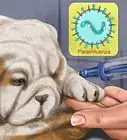This article was co-authored by Alexis Toriello. Alexis Toriello is a Certified Dog Behavior Consultant and the Founder and CEO of Zen Dog Training in New York. Her time working as a canine behavior specialist in various animal shelters has made her knowledgeable in assessing, rehabilitating, and training dogs. In addition to being an Associate Certified Dog Behavior Consultant (ACDBC), Alexis is a Certified Professional Dog Trainer - Knowledge Assessed (CPDT-KA) and a Master’s Degree Candidate in Animal Behavior and Conservation at Hunter College. She is certified by the American Red Cross in Canine First-Aid and CPR and has endorsements from numerous hospitals and clinics and the Washington Humane Society.
There are 8 references cited in this article, which can be found at the bottom of the page.
This article has been viewed 39,369 times.
It can be very frustrating when your dog gets away from you and it can be equally challenging to capture a stray unknown dog. To properly catch a runaway dog you will need to try out a variety of approach methods from calm walking to frantically running away. See what the dog responds to and repeat those actions. Once you are close enough, secure a leash around the dog's head and lead it to safety. Calling on other people for assistance during the capture process is often a good idea as well.
Steps
Making Your Initial Approach
-
1Follow the dog. If you are with the dog when it runs away, discretely follow it and keep it in view without chasing it or being too obvious. At some point, the dog will stop to check out a smell or dodge a person and that is a potential time to move in closer. Try not to make it evident that you are tracking the dog or it will see your pursuit as a game of chase and run even faster.[1]
-
2Entice the dog with tasty treats. Food is your secret weapon. Get out the smelliest, most noticeable treats that you have and take them with you on the hunt. It's best if you have them in a noisy bag that you can rustle. You can simply toss a few treats in the direction of the dog or you could place a few on the ground and bend down to check them out. This action might trigger a dog's curiosity and cause it to come over to see what you are looking at.[2]
- If your dog makes a habit of running away it may be helpful to keep a bag of treats in your car for emergencies.[3]
Advertisement -
3Wait for the dog to come to you. The dog will likely flee if you make it evident that you're pursuing it. This will make the dog view you as a predator and a threat. Instead, stay back and arouse their curiosity so they become interested in approaching you.[4]
- This will only work, of course, if you have the dog in your direct line of vision.
- Waiting the dog out can be a good option when you are trying to catch a runaway dog in an enclosed area.[5]
- Keep in mind that it may take some time for the dog to feel brave enough to approach you.
- Never approach a dog directly as it will cause them to freeze and then turn tail and run. Instead, try to flank them a bit and head into their peripheral vision. This may also trigger their hunting instinct and they may try to catch you instead.[6]
-
4Display non-confrontational body language. Avoid making eye contact and sit or squat down low to the ground so that the dog doesn't perceive you as a threat. Use your peripheral vision to watch the dog without intimidating it and scaring it away.
-
5Move at a medium pace. You may have to be a bit patient as your chase could take upwards of 45 minutes in some cases. Keep trying to close the distance between you and the dog without seeming frantic. This may mean that you maintain a brisk walk as you continually reposition yourself.[7]
-
6
-
7Whistle or call to gain the dog's attention. If you are dealing with an outgoing dog, it is fine to call their name or clap your hands to get their attention. If you are pursuing a shy dog, these actions can be seen as threatening and may cause it to run even more. All things considered, your best bet may be to make high-pitched yipping noises. This will make you sound like potential prey and the dog may turn around to check you out.[10]
- You can also experiment with saying a few words, such as “Come,” in a low and deep tone. Sometimes this is off-putting enough to get a dog's attention.[11]
- A runaway dog is usually either excited or frightened, both of which interfere with their ability to smell familiar scents and register familiar sounds. Because of this, the dog may not recognize or respond to your voice.
-
8Watch for traffic dangers. Try to steer the dog away from busy, traffic congested areas. But, keep an eye out for your own well-being too. Some dog owners or good Samaritans have been hit by cars while trying to assist runaway pets.[12]
Securing the Dog
-
1Secure the leash. When you get close enough to the dog make a slip lead with your leash and place it over the dog's head. Use this new lead to direct the dog back to safety. If it is your dog don't bother making collar adjustments at this point; wait until you are back in a secure location.[13]
-
2Establish a gentle fur hold. If you are without a leash, the dog has long hair, and it is acting overly friendly you may be able to reach down and gently place your hand on its fur. Use your hand to exert slight pressure to direct the dog back to a safe direction.
- With a small dog you may just be able to pick it up. However, if this is a new dog to you make sure that it is not acting aggressively before you try to lift it or you may get bitten.
-
3Offer the dog a few treats to encourage compliance. As you are securing the dog and making your way back, place a couple of treats on the ground in front of the dog. This will encourage them to keep moving and will associate their capture with positive memories instead of fearful or negative ones.[14]
-
4Place the dog in your backseat. If you must travel by car with the dog, gently load it into the backseat. Try to keep an eye out for any signs of agitation, such as growling. You should also note that if your dog likes riding in the car you can sometimes capture them by simply driving up and saying, “Get in!”[15]
-
5Guide the dog home. If you are walking home with the dog, just try to keep a moderate pace. If you go too slow, the dog may get restless and try to run again. If you go too fast, you may trigger the chase or hunting instinct as well. Aim for a brisk, determined walk.
-
6Call animal control. This is generally a last resort, especially if the dog will be taken to a shelter that performs euthanasia. But, if the runaway dog presents a mass safety risk to others, is about to be injured, or is already injured, it may be a good idea to make the call. This is the case, for example, if a dog is running in the middle of a major freeway.
Tracking Down a Lost Dog
-
1Look in the usual places. If it is your pet that has run off, think about where they might have gone. Is the dog park nearby? Is there a neighboring dog of interest? Consider your search diameter to be just a few miles initially, but expand it to 20 miles if your dog stays out for the entire day.[16]
-
2Ask a passerby. Call out to other people that you see on the street and tell them that your dog is out. Or, draw their attention to the stray dog that you've just noticed. Make hand gestures or verbally ask them to help you catch the dog. If your dog has gone loose at a grooming facility or a similar dog-related place, go inside and ask the employees for help.[17]
-
3Alert your family or friends. Send out a quick text message or a make a phone call asking everyone to head over quickly to help. Time is of the essence, so the quicker they arrive the better. If they are also dog owners you can ask them to bring their dogs along as you may be able to use them to lure your dog back.[18]
- Only use other dogs as bait if you know that they are friendly and non-aggressive. Otherwise, you could create a potential dog-fight situation.
-
4Notify a rescue organization. Search online with your location and “lost dog help” to find a rescue group near you. They may be able to lend you manpower right away or they may give you live traps to use in the long run. They can also offer some tips regarding dog behavior that may lead to an immediate recapture.[19]
-
5Call local veterinary clinics. Call vets in the area to see if anyone has turned in an injured dog that matches your dog's description. Dogs that have escaped from their homes may become lost and confused, especially when in unfamiliar areas. This makes them more susceptible to doing dangerous things, such as crossing busy streets. By checking different vet offices, you may be able to find your runaway dog if it's injured.
Expert Q&A
-
QuestionHow do I catch a dog that won't come to me?
 Alexis TorielloAlexis Toriello is a Certified Dog Behavior Consultant and the Founder and CEO of Zen Dog Training in New York. Her time working as a canine behavior specialist in various animal shelters has made her knowledgeable in assessing, rehabilitating, and training dogs. In addition to being an Associate Certified Dog Behavior Consultant (ACDBC), Alexis is a Certified Professional Dog Trainer - Knowledge Assessed (CPDT-KA) and a Master’s Degree Candidate in Animal Behavior and Conservation at Hunter College. She is certified by the American Red Cross in Canine First-Aid and CPR and has endorsements from numerous hospitals and clinics and the Washington Humane Society.
Alexis TorielloAlexis Toriello is a Certified Dog Behavior Consultant and the Founder and CEO of Zen Dog Training in New York. Her time working as a canine behavior specialist in various animal shelters has made her knowledgeable in assessing, rehabilitating, and training dogs. In addition to being an Associate Certified Dog Behavior Consultant (ACDBC), Alexis is a Certified Professional Dog Trainer - Knowledge Assessed (CPDT-KA) and a Master’s Degree Candidate in Animal Behavior and Conservation at Hunter College. She is certified by the American Red Cross in Canine First-Aid and CPR and has endorsements from numerous hospitals and clinics and the Washington Humane Society.
Certified Dog Behavior Consultant Try walking or running in the opposite direction of the dog so it chases after you.
Try walking or running in the opposite direction of the dog so it chases after you.
Warnings
- Do not punish your dog for running away. This is counterproductive and can actually lead to more flight problems.⧼thumbs_response⧽
- Be very careful approaching a stray dog. Try not to corner it as you may trigger a fight or flight response.[21]⧼thumbs_response⧽
References
- ↑ http://www.petboardinganddaycare.com/dog-on-the-loose/
- ↑ https://www.luckydoganimalrescue.org/sites/default/files/library/documents/What-toDo-When-a-Lost-Dog-is-Sighted.pdf
- ↑ https://www.petfinder.com/dogs/lost-and-found-dogs/tips-for-catching-lost-dogs/
- ↑ Alexis Toriello. Certified Dog Behavior Consultant. Expert Interview. 23 February 2021
- ↑ https://www.pethub.com/article/pet-safety/lost-pet-advice-understanding-dog-behavior
- ↑ http://www.petboardinganddaycare.com/dog-on-the-loose/
- ↑ https://www.luckydoganimalrescue.org/sites/default/files/library/documents/What-toDo-When-a-Lost-Dog-is-Sighted.pdf
- ↑ Alexis Toriello. Certified Dog Behavior Consultant. Expert Interview. 23 February 2021
- ↑ http://www.petboardinganddaycare.com/dog-on-the-loose/
- ↑ http://www.petboardinganddaycare.com/dog-on-the-loose/
- ↑ http://washingtonpashelter.org/wp-content/uploads/2015/04/How-to-Catch-a-Loose-Dog.pdf
- ↑ http://www.standard.co.uk/news/london/pictured-man-who-died-running-into-road-to-catch-his-runaway-dog-a3191206.html
- ↑ https://www.luckydoganimalrescue.org/sites/default/files/library/documents/What-toDo-When-a-Lost-Dog-is-Sighted.pdf
- ↑ https://www.pethub.com/article/pet-safety/lost-pet-advice-understanding-dog-behavior
- ↑ http://www.petboardinganddaycare.com/dog-on-the-loose/
- ↑ https://www.pethub.com/article/pet-safety/lost-pet-advice-understanding-dog-behavior
- ↑ http://www.petboardinganddaycare.com/dog-on-the-loose/
- ↑ http://washingtonpashelter.org/wp-content/uploads/2015/04/How-to-Catch-a-Loose-Dog.pdf
- ↑ http://theretrievers.org/humane-capture-of-skittish-dogs/
- ↑ http://www.petboardinganddaycare.com/dog-on-the-loose/
- ↑ https://www.luckydoganimalrescue.org/sites/default/files/library/documents/What-toDo-When-a-Lost-Dog-is-Sighted.pdf
About This Article
To catch a runaway dog, whether it’s your own or a stray, follow it at a distance until it stops so it doesn’t think you’re playing chase. Then, hang back and let the dog approach you so it doesn't view you as a threat. Try using a tasty, smelly treat to lure it back. If the dog doesn’t approach or keeps running, try suddenly running in the opposite direction, since this might encourage the dog to chase after you. Once you reach the dog, secure it with a leash or hold its fur to stop it running off again. If you have treats with you, give them to the dog to keep it calm. For more tips from our Veterinary co-author, including how to search for a lost dog, read on!
